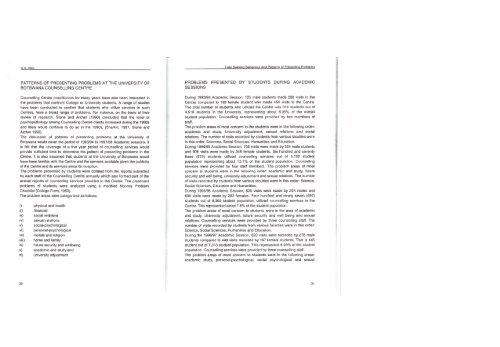Download (441Kb) - Covenant University Repository
Download (441Kb) - Covenant University Repository
Download (441Kb) - Covenant University Repository
Create successful ePaper yourself
Turn your PDF publications into a flip-book with our unique Google optimized e-Paper software.
A.A. Alao<br />
Helo Seekina Behaviourand Patterns of Presenting Problems<br />
PATTERNS OF PRESENTING PROBLEMS AT THE UNIVERSITY OF<br />
BOTSWANA COUNSELLING CENTRE<br />
Counselling Centre practitioners for many years have also been interested in<br />
the problems that confront College or <strong>University</strong> students. A range of studies<br />
have been conducted to confirm that students who utilize services in such<br />
Centres, have a broad range of problems. For instance, on the basis of their<br />
review of research, Stone and Archer (1990) concluded that the level of<br />
psychopathology among Counselling Centre clients increased during the 1980s<br />
and likely would continue to do so in the 1990s, {Sharkin, 1997, Stone and<br />
Archer 1990).<br />
The discussion of patterns of presenting problems at the <strong>University</strong> of<br />
Botswana would cover the period of 1993/94 to 1997/98 Academic sessions. It<br />
is felt that the coverage of a five year period of counselling services would<br />
provide sufficient time to determine the pattern of presenting problems in the<br />
Centre. It is also assumed that students at the <strong>University</strong> of Botswana would<br />
have been familiar with the Centre and the services available given the publicity<br />
of the Centre and its services since its inception.<br />
The problems presented by students were collated from the reports submitted<br />
by each staff of the Counselling Centre annually which also formed part of the<br />
annual reports of counselling services provided in the Centre. The presented<br />
problems of students were analyzed using a modified Mooney Problem<br />
Checklist (College Form, 1950).<br />
The problem areas were categorised as follows:<br />
i) physical and health<br />
ii) financial<br />
iii) social relations<br />
iv) sexual relations<br />
v) social-psychological<br />
vi) personal-psychological<br />
vii) morals and religion<br />
viii) home and family<br />
ix) future security and wellbeing<br />
x) academic and study and<br />
xi) university adjustment<br />
PROBLEMS PRESENTED BY STUDENTS DURING ACADEMIC<br />
SESSIONS<br />
During 1993/94 Academic Session, 125 male students made 288 visits to the<br />
Centre compared to 189 female student who made 454 visits to the Centre.<br />
The total number of students who utilized the Centre was 314 students out of<br />
4,518 students in the <strong>University</strong>, representing about 6.95% of the overall<br />
student population. Counselling services were provided by two members of<br />
staff.<br />
The problem areas of most concern to the students were in the following order:<br />
academic and study, <strong>University</strong> adjustment, sexual relations and social<br />
relations. The number of visits recorded by students from various faculties were<br />
in this order: Sciences, Social Sciences, Humanities and Education.<br />
During 1994/95 Academic Session, 756 visits were made by 324 male students<br />
and 908 visits were made by 349 female students. Six hundred and seventy<br />
three (673) students utilized counselling services out of 5,132 student<br />
population representing about 13.1% of the student population. Counselling<br />
services were provided by four staff members. The problem areas of most<br />
concern to students were in the following order: academic and study, future<br />
security and well being, university adjustment and sexual relations. The number<br />
of visits recorded by students from various faculties were in this order: Science,<br />
Social Sciences, Education and Humanities.<br />
During 1995/96 Academic Session, 525 visits were made by 204 males and<br />
699 visits were made by 293 females. Four hundred and ninety seven (497)<br />
students out of 6,360 student population, utilized counselling services in the<br />
Centre. This represented about 7.8% of the student population.<br />
The problem areas of most concern to students were in the area of academic<br />
and study, <strong>University</strong> adjustment, future security and well being and sexual<br />
relations. Counselling services were provided by three counselling staff. The<br />
number of visits recorded by students from various faculties were in this order:<br />
Science, Social Sciences, Humanities and Education.<br />
During the 1996/97 Academic Session, 620 visits were recorded by 278 male<br />
students compared to 448 visits recorded by 167 female students. That is 445<br />
student out of 7,313 student population. This represented 6.09% of the student<br />
population. Counselling services were provided by three counselling staff.<br />
The problem areas of most concern to students were in the following areas:<br />
academic study, personal-psychological, social psychological and sexual<br />
30<br />
31
















